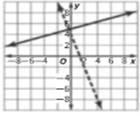
A figure is given as follows:

And we have to choose the correct option from four given alternatives.
Answer to Problem 9PFA
The correct option is “B”.
Explanation of Solution
By looking carefully we can find that dotted line passes through points
(-2, 10) and (2,-2)
So its slope, is
By looking carefully again we can find that darked line passes through points
(10, 8) and (-2, 4)
So its slope, is
Now since,
Chapter 4 Solutions
Glencoe Algebra 1, Student Edition, 9780079039897, 0079039898, 2018
Additional Math Textbook Solutions
University Calculus: Early Transcendentals (4th Edition)
Elementary Statistics: Picturing the World (7th Edition)
Precalculus
Thinking Mathematically (6th Edition)
Pre-Algebra Student Edition
Calculus: Early Transcendentals (2nd Edition)
- Consider the function f(x)=x³ + 2x² − 3 (a) Graph the function. (b) What are the x- and y-intercepts of the graph?arrow_forwardLet 2 A = 4 3 -4 0 1 (a) Show that v = eigenvalue. () is an eigenvector of A and find the corresponding (b) Find the characteristic polynomial of A and factorise it. Hint: the answer to (a) may be useful. (c) Determine all eigenvalues of A and find bases for the corresponding eigenspaces. (d) Find an invertible matrix P and a diagonal matrix D such that P-¹AP = D.arrow_forward(c) Let 6 0 0 A = -10 4 8 5 1 2 (i) Find the characteristic polynomial of A and factorise it. (ii) Determine all eigenvalues of A and find bases for the corresponding eigenspaces. (iii) Is A diagonalisable? Give reasons for your answer.arrow_forward
- most 2, and let Let P2 denote the vector space of polynomials of degree at D: P2➡ P2 be the transformation that sends a polynomial p(t) = at² + bt+c in P2 to its derivative p'(t) 2at+b, that is, D(p) = p'. (a) Prove that D is a linear transformation. (b) Find a basis for the kernel ker(D) of the linear transformation D and compute its nullity. (c) Find a basis for the image im(D) of the linear transformation D and compute its rank. (d) Verify that the Rank-Nullity Theorem holds for the linear transformation D. (e) Find the matrix representation of D in the standard basis (1,t, t2) of P2.arrow_forward(c) Let A = -1 3 -4 12 3 3 -9 (i) Find bases for row(A), col(A) and N(A). (ii) Determine the rank and nullity of A, and verify that the Rank-Nullity Theorem holds for the above matrix A.arrow_forward-(0)-(0)-(0) X1 = x2 = x3 = 1 (a) Show that the vectors X1, X2, X3 form a basis for R³. y= (b) Find the coordinate vector [y] B of y in the basis B = (x1, x2, x3).arrow_forward
- Let A 1 - 13 (1³ ³) 3). (i) Compute A2, A3, A4. (ii) Show that A is invertible and find A-¹.arrow_forwardLet H = {(a a12 a21 a22, | a1 + a2 = 0} . € R²x²: a11 + a22 (i) Show that H is a subspace of R2×2 (ii) Find a basis of H and determine dim H.arrow_forward2 5 A=1 2 -2 b=2 3 1 -1 3 (a) Calculate det(A). (b) Using (a), deduce that the system Ax = b where x = (x1, x2, x3) is consistent and determine x2 using Cramer's rule.arrow_forward
- Consider the least squares problem Ax = b, where 12 -09-0 A 1 3 1 4 and b = (a) Write down the corresponding normal equations. (b) Determine the set of least squares solutions to the problem.arrow_forwardThe function f(x) is represented by the equation, f(x) = x³ + 8x² + x − 42. Part A: Does f(x) have zeros located at -7, 2, -3? Explain without using technology and show all work. Part B: Describe the end behavior of f(x) without using technology.arrow_forwardHow does the graph of f(x) = (x − 9)4 – 3 compare to the parent function g(x) = x²?arrow_forward
 Algebra and Trigonometry (6th Edition)AlgebraISBN:9780134463216Author:Robert F. BlitzerPublisher:PEARSON
Algebra and Trigonometry (6th Edition)AlgebraISBN:9780134463216Author:Robert F. BlitzerPublisher:PEARSON Contemporary Abstract AlgebraAlgebraISBN:9781305657960Author:Joseph GallianPublisher:Cengage Learning
Contemporary Abstract AlgebraAlgebraISBN:9781305657960Author:Joseph GallianPublisher:Cengage Learning Linear Algebra: A Modern IntroductionAlgebraISBN:9781285463247Author:David PoolePublisher:Cengage Learning
Linear Algebra: A Modern IntroductionAlgebraISBN:9781285463247Author:David PoolePublisher:Cengage Learning Algebra And Trigonometry (11th Edition)AlgebraISBN:9780135163078Author:Michael SullivanPublisher:PEARSON
Algebra And Trigonometry (11th Edition)AlgebraISBN:9780135163078Author:Michael SullivanPublisher:PEARSON Introduction to Linear Algebra, Fifth EditionAlgebraISBN:9780980232776Author:Gilbert StrangPublisher:Wellesley-Cambridge Press
Introduction to Linear Algebra, Fifth EditionAlgebraISBN:9780980232776Author:Gilbert StrangPublisher:Wellesley-Cambridge Press College Algebra (Collegiate Math)AlgebraISBN:9780077836344Author:Julie Miller, Donna GerkenPublisher:McGraw-Hill Education
College Algebra (Collegiate Math)AlgebraISBN:9780077836344Author:Julie Miller, Donna GerkenPublisher:McGraw-Hill Education





